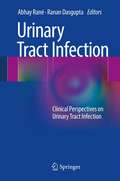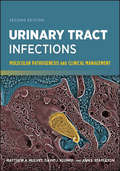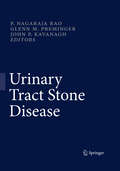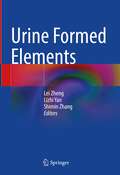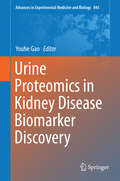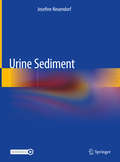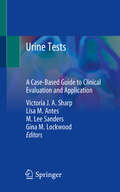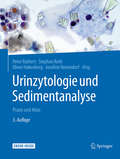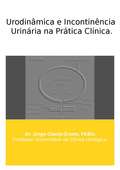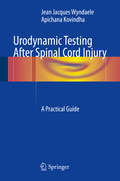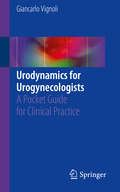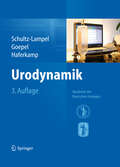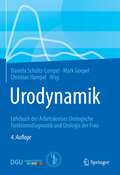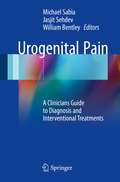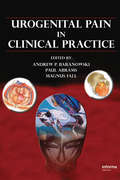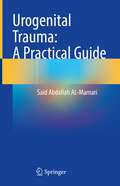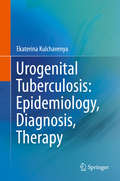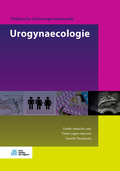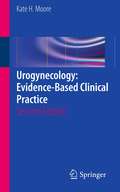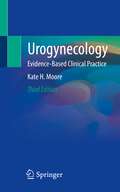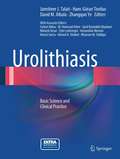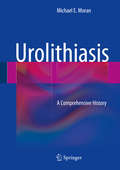- Table View
- List View
Urinary Tract
by Karl-Erik Andersson Martin C. MichelThe basic anatomy and physiology of the urinary tract, the validity of animal models and other methodological considerations as well as a range of potential therapeutic targets are comprehensively reviewed by leading international experts, making this a unique reference source for basic scientists and research-minded clinicians alike
Urinary Tract Infection: Clinical Perspectives on Urinary Tract Infection
by Abhay Rané Ranan DasguptaThe causative organisms of Urinary Tract Infection are dynamic in terms of their virulence and resistance patterns, leading to challenges in the prevention and treatment of urinary infection. This is of relevance in both primary and secondary care, and many of the challenges are similar in both developed and developing countries alike. UTI is also associated with considerable cost in terms of morbidity, economic and research expenditure. Written by an exceptional and well-known team of clinical experts, the purpose of Urinary Tract Infections addresses key questions facing physicians about this condition. This book is written primarily for general physicians who wish to have a broad understanding of a number of important issues concerning infection in parts of the urinary tract. Specialists may also find the book useful as a quick reference guide.
Urinary Tract Infections: Molecular Pathogenesis and Clinical Management (ASM Books)
by Matthew Mulvey David Klumpp Ann StapletonA comprehensive overview of clinically important infections of the urinary tract Urinary tract infections (UTIs) continue to rank among the most common infectious diseases of humans, despite remarkable progress in the ability to detect and treat them. Recurrent UTIs are a continuing problem and represent a clear threat as antibiotic-resistant organisms and infection-prone populations grow. Urinary Tract Infections: Molecular Pathogenesis and Clinical Management brings the scientific community up to date on the research related to these infections that has occurred in the nearly two decades since the first edition. The editors have assembled a team of leading experts to cover critical topics in these main areas: clinical aspects of urinary tract infections, including anatomy, diagnosis, and management, featuring chapters on the vaginal microbiome as well as asymptomatic bacteriuria, prostatitis, and urosepsis the origins and virulence mechanisms of the bacteria responsible for most UTIs, including uropathogenic Escherichia coli, Proteus mirabilis, and Klebsiella pneumoniae the host immune response to UTIs, the rise of antibiotic-resistant strains, and the future of therapeutics This essential reference serves as both a resource and a stimulus for future research endeavors for anyone with an interest in understanding these important infections, from the classroom to the laboratory and the clinic.
Urinary Tract Stone Disease
by Nagaraja P. Rao John P. Kavanagh Glenn M. PremingerUrinary stone disease constitutes more than a quarter of urologists' workload in the Western countries and is more than half in the Middle-East and Central Asian countries. The surgical management of stone disease has changed considerably in the last five years and our understanding of mechanism of stone disease has improved with some old concepts discarded and newer theories gaining ground. Covering the entire spectrum of urinary stone disease and with contributions of more than fifty internationally recognised experts, this exhaustive and complex reference work will be invaluable to all urologists, nephrologists and non-medical scientists.
Urine Formed Elements
by Lei Zheng Lizhi Yan Shimin ZhangThis book introduces the various urinary formed elements comprehensively, mainly including exfoliated cells, crystals and casts. Since the urinary formed elements are affected by various factors and their morphology may change, these components are identified by combining a variety of staining techniques. Various kinds of clinical classic cases are introduced, which are illustrated by richness high-definition colour pictures.
Urine Proteomics in Kidney Disease Biomarker Discovery
by Youhe GaoThis book systematically summarizes the ideas and technologies used in urine proteome analysis. It argues that change is the core of biomarker definition since the body uses its homeostatic mechanisms to correct changes in the blood. This means that urine is probably a better source of biomarkers than blood. A roadmap to the urinary biomarker era is proposed, and researchers are reminded of the potential opportunities and risks in their study design. Kidney diseases are emphasized as they produce the most significant changes in urine. This book tries to show researchers and graduate students, who are in or entering the field, "all things considered" rather than "the current affair".
Urine Sediment
by Josefine NeuendorfThis book is a comprehensive resource and up-to-date description of all urinary sediment constituents which are presented in bright-field mode and in phase-contrast mode. Thanks to numerous detailed images of urinary sediment constituents, the reader is able to easily compare what they view microscopically with high-resolution photographs and short films. The book is also designed to aid the identification of rare urine constituents in their native state without prior staining. It also features guidance on how set-up a microscope , microscopy techniques, and preanalytics. Exercises focused on microscopic analysis and diagnosis and a urinary sediment quiz reinforce key concepts to aid learning. Urine Sediment provides a practically applicable guide to the recognition of urinary sediment constituents. It is therefore a critical resource for trainees and experienced practitioners in urology, nephrology, gynecology and general practice who need to be able to accurately and quickly identify urine sediment constituents.
Urine Tests: A Case-Based Guide to Clinical Evaluation and Application
by Victoria J. A. Sharp Lisa M. Antes M. Lee Sanders Gina M. LockwoodUrine tests are used by a variety of primary care providers and specialists in order to diagnose, monitor and treat patients with various medical conditions. This first-of-its-kind text is a comprehensive clinical guide to the evaluation and application of urine tests. Clinical cases are used to highlight important aspects of urine testing. Further evaluation and management are then discussed based on the results of the urine tests. Topics covered include financial considerations, regulations, proper collection, testing methods, dipstick analysis, microscopy as well as cancer and drug screening tests, among others. Each chapter contains specific objectives for focus of study. Pertinent images, algorithms and board style review questions for important topics are also included. Written by nephrologists, urologists, other specialists and primary care physicians, Urine Tests uses a comprehensive approach to the clinical use of both common and uncommon urine testing. Primarily appealing to practicing primary care physicians, this book is also a useful resource for specialists, nurse practitioners, physician assistants, physician fellows, residents and medical students alike.
Urine: Promising Biomarker Source for Early Disease Detection (Advances in Experimental Medicine and Biology #Vol. 845)
by Youhe GaoThis book demonstrates the potential of urine as a biomarker resource for early disease detection, covering the related theory, strategies, tools and findings. Biomarkers are measurable changes associated with diseases. Blood, as a critical part of its internal environment, is closely monitored and controlled by the body to maintain homeostasis, especially in the early stages of diseases. In contrast, urine, as a form of waste excreted by the body, collects a variety of substance changes. Accordingly, urine can offer an ideal resource for early biomarker discovery. In addition, urine is more stable than blood in vitro, and is easy to store and analyze. The book discusses exciting preliminary applications of urine biomarkers for diseases affecting major biological systems. Its main goal is to make scientists, clinicians and medical companies aware of this important, exciting, undeveloped, and profitable field.
Urinzytologie und Sedimentanalyse
by Stephan Roth Josefine Neuendorf Peter Rathert Oliver HakenbergDieses Buch kombiniert zum ersten Mal zwei der wichtigsten Untersuchungen des Harns in einem Werk – onkologische Urinzytologie und Urinsedimentanalyse.Das Standardwerk zur Urinzytologie wurde mit der 5.Auflage umfassend aktualisiert und bedeutsam ergänzt. Dies erfolgte im Hinblick auf die Qualitätsicherungsmaßnahmen in der Urindiagnostik und zur Erweiterung des diagnostischen Potentials der Präparate. Neu: Die Indikationen zur Urinzytologie haben sich erweitert, insbesondere durch die Empfehlungenin der S-3 Leitlinie zum Blasenkarzinom.Komplettes Kapitel zur UrinsedimentanalyseDie Nomenklatur zur Befundbeschreibung wurde präzisiert und um die Pariser Nomenklatur erweitert.Die umfassende und kritische Analyse zu den molekularen Markern wurde aktualisiert um Perspektiven für die Zukunft. Informieren Sie sich über:Indikationsspektrum und LimitationenPräparations- und Färbetechnikenpraxisgerechte Arbeitsabläufeadäquate Befund-Dokumentation (nach WHO-Kriterien)neue Entwicklungen auf dem Gebiet uringebundener Markersysteme und der Immunzytologie Besonders nützlich für die tägliche Arbeit:konkrete Hinweise zur Differentialdiagnostikein ausführlicher Atlasteil mit über 220 Farbabbildungen zur Veranschaulichung zytologischer und sedimentanalytischer Kriterien und Besonderheiten
Urodinâmica e Incontinência Urinária na Prática Clínica
by Ana Dias Jorge Clavijo EiseleA incontinência urinária (IU) é um sintoma comum que se apresenta em diferentes doenças e afeta todos os grupos populacionais, etários e ambos os sexos, apesar de ser mais frequente na mulher do que no homem. É uma patologia importante devido à sua frequência, gravidade, conotações psicológicas, sociais e económicas. Uma em cada 30 pessoas sofre de incontinência. Mulheres, idosos, crianças e doentes neurológicos apresentam um problema médico e social objetivo e também danos psicológicos subjetivos. Será que já existe uma solução para a incontinência? Podemos apresentar soluções definitivas em muitos casos, seja através da medicação ou através de soluções cirúrgicas e tratamentos paliativos que impeçam os doentes de se isolarem. Tentamos fazer com que os doentes que sofram de incontinência urinária sejam corresponsáveis pelo seu próprio tratamento, e sejam ativos relativamente aos seus cuidados. O que é conseguido através das informações e formações sobre a incontinência urinária do doente, e de todos os responsáveis pela sua saúde incluindo: assistentes sociais, auxiliares de enfermagem, enfermeiros, médicos e todos os que estiverem envolvidos nos cuidados da pessoa que sofre de incontinência.
Urodynamic Testing After Spinal Cord Injury
by Jean Jacques Wyndaele Apichana KovindhaThis book aims to provide a guide for urodynamic investigation in individuals who have suffered spinal cord injuries. It is universally acknowledged that this type of investigation is valuable and most international guidelines consider it mandatory in patients with neurogenic bladder dysfunction. The book offers an evidence based knowledge of applicability, clinical value, and limitation, and will give the reader strong diagnostic outcomes that will benefit patients suffering from spinal cord injuries. What is presented in this book is based on expert opinions acquired over decades of urodynamic testing that have taken place in different parts of the world.
Urodynamics for Urogynecologists: A Pocket Guide for Clinical Practice
by Giancarlo VignoliThis book offers gynecologists and urogynecologists a pocket guide to urodynamic testing in women with lower urinary tract symptoms. In female urology, the main indications for urodynamics are urinary incontinence, pelvic organ prolapse, urgency-frequency syndrome (also known as overactive bladder), emptying disorders and painful bladder. By collecting quantitative measurements while reproducing the patient’s voiding symptoms where appropriate and possible, urodynamics helps to identify the cause of symptoms, supports management and facilitates prognoses. However, despite the undeniable advantages, the role of urodynamics in female urology is hotly debated. The book starts by describing the physiological background and methodological considerations for urodynamic best practice in the preclinical setting. It then explains how to perform urodynamics correctly – so-called “good urodynamic practice” – to increase the readers’ confidence and ability to perform and interpret urodynamic investigations. Lastly, it reviews the advantages and disadvantages of urodynamic testing in each of the key clinical female urology conditions. A separate chapter focuses on the peculiarities of diagnosis and management for female patients with neurogenic bladder. This guide offers a valuable tool for gynecologists, urologists and urogynecologists, as well as a ready source of information for all physicians involved in diagnosing and treating lower urinary tract disorders in women.
Urodynamik
by Axel Haferkamp D. Schultz-Lampel Mark GoepelDas deutschsprachige Standardwerk zur Urodynamik - jetzt in 3. Auflage! Urodynamik - ein für viele Anwender komplexes Verfahren - leicht gemacht? Genau das gelingt diesem Buch. Vertrauen Sie den Experten aus dem Arbeitskreis "Urologische Funktionsdiagnostik und Urologie der Frau" der DGU, die als Herausgeber und Autoren eine detaillierte Darstellung der Grundlagen und ihrer Anwendungsmöglichkeiten geschaffen haben. Hier finden Sie alle wichtigen Informationen zu Indikation, Durchführung der Untersuchung und Interpretation der Befunde. Zahlreiche Beispiele aus der Praxis erläutern die schwierige Materie anschaulich und verständlich. Alle speziellen Anwendungsgebiete werden nochmal gesondert beleuchtet: spezielle Urodynamik der Frau, des Mannes, des Kindes und des alten Menschen sowie Urodynamik bei Patienten mit neurogener Blasenfunktionsstörung. Die Neuauflage des bewährten Standardwerkes wurde komplett neu überarbeitet und aktualisiert: für eine unproblematische Durchführung der Diagnostik und zum Wohle Ihrer Patienten.
Urodynamik: Lehrbuch des Arbeitskreises Urologische Funktionsdiagnostik und Urologie der Frau
by Mark Goepel Daniela Schultz-Lampel Christian HampelDas deutschsprachige Standardwerk zur Urodynamik – jetzt in 4. Auflage! Urodynamik – ein für viele Anwender komplexes Verfahren – wird in diesem Buch praxisnah und strukturiert erläutert. Die Experten aus dem Arbeitskreis „Urologische Funktionsdiagnostik und Urologie der Frau“ der DGU, haben als Herausgeber und Autoren eine detaillierte Darstellung der Funktionsdiagnostik des unteren Harntrakts und ihrer Anwendungsmöglichkeiten geschaffen. Hier finden Sie alle wichtigen Informationen zu Indikation, Durchführung der Untersuchung und Interpretation der Befunde. Zahlreiche Beispiele aus der Praxis erläutern die komplexe Diagnostik anschaulich und verständlich. Auch die spezielle Urodynamik der Frau, des Mannes, des Kindes und des alten Menschen sowie Urodynamik bei Patienten mit neurologischen Erkrankungen werden besprochen. Die Neuauflage des bewährten Standardwerkes wurde komplett überarbeitet und aktualisiert. Ein echtes Praxisbuch und hilfreicher Begleiter in der urodynamischen Diagnostik.
Urogenital Cancers: An Interdisciplinary Approach (Interdisciplinary Cancer Research #16)
by Nima RezaeiThe “Urogenital Cancers: An Interdisciplinary Approach” is the sixteenth volume of the “Interdisciplinary Cancer Research” series, publishes comprehensive volume on diagnosis and treatment of urogenital cancers. The volume starts with a general chapter on interdisciplinary approach in genitourinary cancers. After discussion on upper tract urothelial carcinoma, bladder cancer, and renal cell carcinoma, immunobiology of testicular cancer is explained. The subsequent chapters are focused on prostate cancer. This is the main concept of Cancer Immunology Project (CIP), which is a part of Universal Scientific Education and Research Network (USERN). This interdisciplinary book will be of special value for urologists, nephrologists, and oncologists who wish to have an update on diagnosis and treatment of urogenital cancers.
Urogenital Pain
by Michael Sabia Jasjit Sehdev William BentleyThis book provides an up to date, comprehensive, review of the common urogenital painful conditions. It will serve as a valuable resource for clinicians, urologists, surgeons, gynecologists, palliative care physicians, and many other medical providers. The book reviews presenting signs and symptoms, diagnostic workup, differential diagnoses, interventional treatments, and alternative medical therapy for painful conditions that occur in the urogenital region. The text also provides a clear understanding of how pain is transmitted along with what patient populations are at increased risk in suffering these conditions. The risks, benefits, and indications are discussed in detail for the variety of interventional injections that are available to help manage these conditions.
Urogenital Pain in Clinical Practice
by Magnus Fall Paul Abrams Andrew Paul BaranowskiDeveloped by an authoritative and multidisciplinary team of contributors well-recognized for their dedication to the care of urogenital pain patients, this source addresses the latest clinical guidelines for the management of urogenital pain and covers the mechanisms and clinical treatment of pain syndromes of the urogenital area in both the male a
Urogenital Trauma: A Practical Guide
by Said Abdallah AL-MamariThis book is written in a unique style that immediately catches the reader's interest and takes him on an enjoyable and fruitful journey from the kidneys to the male genital organs. Throughout the chapters, the researchers, the practitioners, and the junior doctors under urological training are offered a rare opportunity to rapidly refresh their knowledge with updated information starting from the mythical and historical conception of the involved organ, its embryology and anatomy, and progressing to the epidemiology, etiology, anatomopathology, mechanism, treatment and prognosis of its trauma.It aims to provide the reader with the most complete and practical information possible and includes an abundant and well-selected illustration to help the learning process. A special section on male genital self-mutilations is added at the end of the book as the icing on the cake, treating this phenomenon systematically with a harmonious marriage between mythology, history, and a comprehensive literature review and management strategies. This manual has been reviewed and recommended by an internationally renowned expert in urogenital trauma and reconstructive surgery and is a very useful vade mecum for every Practitioner or resident in Urology.
Urogenital Tuberculosis: Epidemiology, Diagnosis, Therapy
by Ekaterina KulchavenyaThis book approaches the classification, pathogenesis, diagnostic, therapy and surgery for kidney tuberculosis as well as male genital tuberculosis. The reader will find recent data on epidemiology, many interesting history cases with illustrations and new methods for the identification of Mycobacterium tuberculosis.
Urogynaecologie (Praktische huisartsgeneeskunde)
by Toine Lagro-Janssen Doreth TeunissenDit boek helpt huisartsen bij de diagnostiek en behandeling van 35 veelvoorkomende urologische en gynaecologisch klachten. Het is het eerste leerboek over dit onderwerp dat zich specifiek richt op professionals in de eerstelijnszorg. Tevens is het geschikt voor andere zorgprofessionals. Urogynaecologie verbreedt en verdiept klachten en ziektebeelden, besteedt aandacht aan nieuwe thema’s en ontwikkelingen, en biedt praktische handvatten. Het richt zich op zorg in de eerste lijn. Ook vervolgbehandelingen in de tweede lijn komen in diverse hoofdstukken aan bod. In het eerste deel van het boek leest u over algemene urogynaecologische thema’s als embryologie, anatomie, hormonale (patho)fysiologie bij man en vrouw, seksuele problemen, en aanvullend echo-onderzoek. Het tweede deel richt zich op specifieke klachten en ziektebeelden, zoals menstruatieklachten, subfertiliteit, preconceptiezorg, LUTS, en klachten over de uitwendige genitalia van vrouwen én mannen. In het derde deel komen aandachtsgebieden als genderincongruentie, vrouwenbesnijdenis, seksueel misbruik en urogenitale traumata aan bod. Ongeveer twintig auteurs schreven mee aan Urogynaecologie. De redactie was in handen van Toine Lagro-Janssen, hoogleraar Vrouwenstudies Medische Wetenschappen en kaderhuisarts urogynaecologie np, en Doreth Teunissen, huisarts en kaderhuisarts urogynaecologie.Urogynaecologie verschijnt in de reeks Praktische huisartsgeneeskunde. In deze reeks verschijnen uitgaven met praktische en klachtgerichte informatie over de verschillende deelgebieden in de huisartsgeneeskunde.
Urogynecology: Evidence-Based Clinical Practice
by Kate H. MooreUrogynecology: Evidence-Based Clinical Practice 2nd Edition is a fully revised and updated text providing an evidence based approach to the treatment of urinary incontinence and prolapse. This updated version incorporates new evidence in the areas of continence procedures, prolapse management, mesh usage and complications; in addition to new insights into Sacral Nerve Stimulation for refractory detrusor overactivity. Written by a leading expert in the field, Urogynecology: Evidence-Based Clinical Practice 2nd Edition is a handy how-to guide, valuable for the junior registrar assigned to work in a urogynecology department, as well as for those with no previous formal urogynecological training who wish to know more about the subject.
Urogynecology: Evidence-Based Clinical Practice
by Kate H. MooreThis heavily revised third edition concisely covers the latest evidence-based treatment strategies for urinary incontinence and prolapse. Chapters cover methodologies relevant to continence procedures, prolapse management, and potential complications. New topics discussed include Colpocleisis, principles associated with managing Mesh complications and the Mirabegron mechanism.Urogynecology: Evidence-Based Clinical Practice 3rd Edition is a vital how-to guide, which is ideal for junior registrars assigned to work in a urogynecology department, as well as for those with no previous formal urogynecological training seeking to develop their understanding of the subject.
Urolithiasis
by Zhangqun Ye Jamsheer J. Talati Hans-Goran Tiselius David M. AlbalaUrolithiasis: Basic Science and Clinical Practice is a comprehensive text that assists urologists in defining the best choice of treatment for each case through a balanced presentation of underlying science, diagnostic methods and practical tips, with additional discussions on educational issues, costs and management of resources. This user-friendly practical resource is replete with full-color illustrations and radiographs, covering all aspects of stone disease, and offering perspectives from Europe, the Americas, China, South Asia, Africa, and Australia. Topics include the biochemical and physiological basis of stone formation, treatment options, complications, assessment of techniques and technologies available, and guidelines on the prevention of stone recurrence. Urolithiasis: Basic Science and Clinical Practice is the definitive text on stone disease and is a must read for young consultants starting a new practice, and urologists in residence and training.
Urolithiasis
by Michael E. MoranUrolithiasis: A Comprehensive History provides a historical sojourn into the varied manifestations of kidney stone disease. Utilizing historical sources and integrating classic material with new concepts, this new volume provides depth and details on stone disease not found in modern overviews on the topic. This volume serves as a very useful tool for physicians and researchers dealing with kidney stone disease. Written by a renowned expert in the field, Urolithiasis: A Comprehensive History is an in depth resource that heightens our medical understanding of this ancient disease and is of great value to urologists, nephrologists, endocrinologists interested in stone disease.

